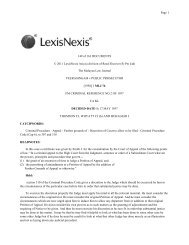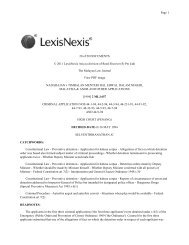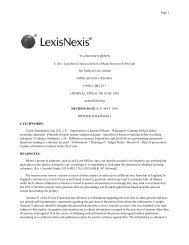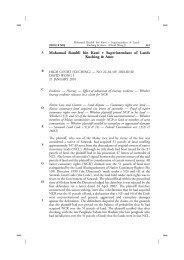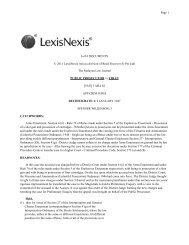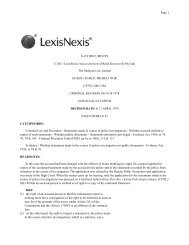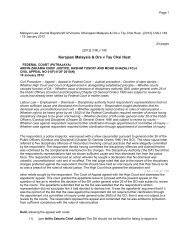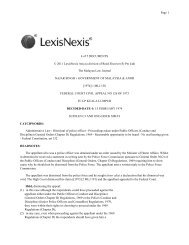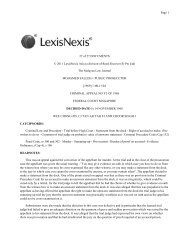Meor Atiqulrahman bin Ishak - ILMS - Attorney General's Chambers
Meor Atiqulrahman bin Ishak - ILMS - Attorney General's Chambers
Meor Atiqulrahman bin Ishak - ILMS - Attorney General's Chambers
Create successful ePaper yourself
Turn your PDF publications into a flip-book with our unique Google optimized e-Paper software.
A<br />
B<br />
C<br />
D<br />
E<br />
F<br />
G<br />
H<br />
I<br />
[2006] 4 MLJ<br />
<strong>Meor</strong> <strong>Atiqulrahman</strong> <strong>bin</strong> <strong>Ishak</strong> v Fatimah bte Sihi<br />
(Abdul Hamid Mohamad FCJ)<br />
605<br />
<strong>Meor</strong> <strong>Atiqulrahman</strong> <strong>bin</strong> <strong>Ishak</strong> (an infant, by his guardian ad litem,<br />
Syed Ahmad Johari <strong>bin</strong> Syed Mohd) & Ors v<br />
Fatimah bte Sihi & Ors<br />
FEDERAL COURT (PUTRAJAYA) — CIVIL APPLICATION NO 01–3 OF<br />
2005(N)<br />
ABDUL MALEK AHMAD PCA, STEVE SHIM CJ (SABAH & SARAWAK)<br />
AND ABDUL HAMID MOHAMAD FCJ<br />
12 JULY 2006<br />
Constitutional Law — Fundamental liberties — Freedom of religion — Prohibition<br />
against wearing of turban by male students in schools — Whether regulations prohibiting<br />
wearing of turban by school pupils during school hours violated art 11(1) of the Federal<br />
Constitution — Whether right to wear a turban was integral part of the religion of Islam<br />
— Test to be applied<br />
The three appellants were primary school students at Sekolah Kebangsaan Serting<br />
Hilir (FELDA), Bandar Baru Serting, Negeri Sembilan. The school had issued the<br />
Peraturan Sekolah Kebangsaan Serting (FELDA) 1997 (‘the School Regulations<br />
1997’), made pursuant to Surat Pekeliling Ikhtisas Bil. 9/1975 issued by the Ministry<br />
of Education. Regulation 3 of the School Regulations 1997 stipulated the uniform<br />
for male pupils. Regulation 3(i)(i) specifically prohibited all pupils from wearing<br />
‘jubah, turban (serban), topi, ketayap dan purdah’. The appellants wore turban as<br />
part of the school uniform to school. They were advised repeatedly not to do so and<br />
to comply with the School Regulations 1997 but they refused. As a result,<br />
on 3 November 1997, the appellants were expelled from the school with effect from<br />
10 November 1997. The appellants challenged their dismissal in court. The learned<br />
judge found in their favour, inter alia, ruling that the School Regulations 1997 was<br />
unconstitutional (see [2000] 5 MLJ 375). The Court of Appeal reversed the<br />
judgment of the High Court (see [2005] 2 MLJ 25). The Court of Appeal, in arriving<br />
at its conclusion, applied the test of whether ‘the right to wear a ‘serban’ is an integral<br />
part of the religion of Islam’. The court concluded that there was not a shred of<br />
evidence before the learned judge confirming that the wearing of a serban is<br />
mandatory in Islam and is therefore an integral part of Islam. This court granted leave<br />
to appeal on one issue only: Whether the regulations prohibiting the wearing of<br />
‘serban’ by school pupils during school hours violated art 11(1) of the Federal<br />
Constitution.<br />
Held, dismissing the appeal:<br />
(1) Whether a practice is or is not an integral part of a religion is not the only<br />
factor that should be considered. Other factors are equally important in<br />
considering whether a particular law or regulation is constitutional or not<br />
under art 11(1) of the Federal Constitution. First, there must be a religion.
606 Malayan Law Journal<br />
[2006] 4 MLJ<br />
Secondly, there must be a practice. Thirdly, the practice is a practice of that<br />
religion. All these having been proved, the court should then consider the<br />
importance of the practice in relation to the religion. This is where the<br />
question whether the practice is an integral part of the religion or not becomes<br />
relevant. If the practice is of a compulsory nature or ‘an integral part’ of the<br />
religion, the court should give more weight to it. If it is not, the court, again<br />
depending on the degree of its importance, may give a lesser weight to it<br />
(see para 17).<br />
(2) Even if the court were to accept the view of SP3 that wearing a turban (by adult<br />
Muslim males) is ‘sunat’ or (commendable), it certainly does not rank on the<br />
same level as ‘sunat prayers’ (see para 38). So, the ‘practice’ is of little<br />
significance from the point of view of the religion of Islam, what more,<br />
in relation to under-aged boys. Certainly, it is not a part of ‘Islamic prophetic<br />
teaching’ as submitted by the learned counsel for the appellants (see para 39).<br />
(3) The School Regulations 1997 in so far as it prohibited the students from<br />
wearing turban as part of the school uniform during school hours did not<br />
contravene the provision of art 11(1) of the Federal Constitution and therefore<br />
was not unconstitutional (see para 47).<br />
[Bahasa Malaysia summary<br />
Ketiga-tiga perayu merupakan pelajar sekolah rendah di Sekolah Kebangsaan Serting<br />
Hilir (FELDA), Bandar Baru Serting, Negeri Sembilan. Sekolah itu telah<br />
mengeluarkan Peraturan Sekolah Kebangsaan Serting (FELDA) 1997 (‘Peraturan<br />
Sekolah 1997’), yang dibuat menurut Surat Pekeliling Ikhtisas Bil. 9/1975 yang<br />
dikeluarkan oleh Kementerian Pelajaran. Peraturan 3 kepada Peraturan Sekolah 1997<br />
menetapkan pakaian seragam untuk pelajar lelaki. Peraturan 3(i)(i) dengan<br />
khususnya melarang semua pelajar daripada memakai ‘jubah,serban, topi, ketayap<br />
dan purdah’. Perayu-perayu memakai serban sebagai sebahagian daripada pakaian<br />
seragam ke sekolah. Mereka dinasihatkan berulang kali untuk tidak berbuat begitu<br />
dan untuk mematuhi Peraturan Sekolah 1997 tetapi mereka enggan berbuat<br />
sedemikian. Akibatnya, pada 3 November 1997, perayu-perayu telah dibuang<br />
sekolah mulai 10 November 1997. Perayu-perayu mencabar pemberhentian mereka<br />
di mahkamah. Hakim yang bijaksana membuat keputusan menyebelahi mereka,<br />
antara lain, memutuskan bahawa Peraturan Sekolah 1997 tidak berperlembagaan<br />
(lihat [2000] 5 MLJ 375). Mahkamah Rayuan telah mengakas penghakiman<br />
Mahkamah Tinggi (lihat [2005] 2 MLJ 25). Mahkamah Rayuan, dalam mencapai<br />
keputusan, telah menggunakan ujian sama ada ‘the right to wear a ‘serban’ is an<br />
integral part of the religion of Islam’. Mahkamah tersebut memutuskan bahawa tiada<br />
keterangan di hadapan hakim yang bijaksana yang mengesahkan bahawa pemakaian<br />
serban adalah mandatori dalam Islam dan adalah saling melengkapkan dalam Islam.<br />
Mahkamah ini memberikan kebenaran untuk merayu atas satu persoalan sahaja.<br />
Sama ada peraturan tersebut melarang serban oleh pelajar sekolah semasa waktu<br />
sekolah bertentangan dengan perkara 11(1) Perlembagaan Persekutuan.<br />
A<br />
B<br />
C<br />
D<br />
E<br />
F<br />
G<br />
H<br />
I
A<br />
B<br />
C<br />
D<br />
E<br />
F<br />
G<br />
H<br />
I<br />
[2006] 4 MLJ<br />
<strong>Meor</strong> <strong>Atiqulrahman</strong> <strong>bin</strong> <strong>Ishak</strong> v Fatimah bte Sihi<br />
(Abdul Hamid Mohamad FCJ)<br />
607<br />
Diputuskan, menolak rayuan tersebut:<br />
(1) Sama ada amalan adalah atau bukan sebahagian yang melengkapkan suatu<br />
agama itu bukanlah satu-satunya faktor yang patut dipertimbangkan.<br />
Faktor-faktor lain sama pentingnya dalam mempertimbangkan sama ada suatu<br />
undang-undang atau peraturan tertentu adalah berperlembagaan atau tidak<br />
di bawah perkara 11(1) Perlembagaan Persekutuan. Pertama, perlu ada agama.<br />
Kedua, perlu ada amalan. Ketiga, amalan itu adalah amalan agama.<br />
Setelah kesemuanya dibuktikan, mahkamah hendaklah kemudian<br />
mengambilkira kepentingan amalan itu dalam agama. Di sini persoalan sama<br />
ada amalan itu melengkapkan agama atau tidak bukanlah relevan. Jika amalan<br />
itu suatu yang wajib atau ‘an integral part’ dalam agama, mahkamah patut<br />
menitikberatkannya. Jika tidak, mahkamah, akan sekali lagi bergantung<br />
kepada tahap kepentingannya, memberinya kurang perhatian (lihat<br />
perenggan 17).<br />
(2) Jikapun mahkamah menerima pendapat SP3 bahawa memakai serban<br />
(oleh lelaki dewasa Muslim) adalah ‘sunat’ atau (usaha yang patut dipuji),<br />
ia tidak meletakkannya pada tahap sama seperti solat sunat (lihat perenggan<br />
38). Oleh itu, ‘practice’ itu tidak penting dari pandangan agama Islam, apa<br />
lagi, berkaitan budak lelaki bawah umur. Semestinya, ia bukan sebahagian<br />
daripada ‘Islamic prophetic teaching’ seperti yang dihujahkan oleh peguam<br />
yang bijaksana bagi pihak perayu-perayu (lihat perenggan 39).<br />
(3) Peraturan Sekolah 1997 setakat menghalang pelajar-pelajar daripada memakai<br />
serban sebagai sebahagian daripada seragam sekolah semasa waktu sekolah<br />
tidak bercanggah dengan peruntukan perkara 11(1) Perlembagaan Persekutuan<br />
dan oleh itu tidak berperlembagaan (lihat perenggan 47).]<br />
Notes<br />
For cases on freedom of religion, see 3(1) Mallal’s Digest (4th Ed, 2003 Reissue)<br />
paras 1790–1800.<br />
Cases referred to<br />
Commissioner, The, Hindu Religious Endowments, Madras v Sri Lakshmindra Thirtha<br />
Swamiar AIR 1954 SC 282 (refd)<br />
Commissioner of Police v Acharya Jagadishwaranada Avadhuta (2004) 2 LRI 39 (refd)<br />
Dalip Kaur v Pegawai Polis Daerah, Balai Polis Daerah, Bukit Mertajam & Anor<br />
[1992] 1 MLJ 1 (refd)<br />
Hajjah Halimatussadiah bte Hj Kamaruddin v Public Services Commission Malaysia &<br />
Anor [1994] 3 MLJ 61 (refd)<br />
Javed v State of Haryana AIR 2003 SC 3057 (refd)<br />
Sardar Syedna Taher Saifuddin Saheb v State of Bombay AIR 1962 SC 853 (refd)<br />
Legislation referred to<br />
Federal Constitution art 11(1), (5)<br />
Mohamed Hanipa <strong>bin</strong> Maidin (Muhammad Firdaus <strong>bin</strong> Zakaria, Mohd Fadzli <strong>bin</strong><br />
Mohd Ramly and Abdullah <strong>bin</strong> Abdul Karim with him) (Mohamed Hanipa &<br />
Associates) for the appellant.
608 Malayan Law Journal<br />
[2006] 4 MLJ<br />
Dato’ Umi Kalthum bte Abdul Majid (Azizah bte Haji Nawawi with her) (Senior<br />
Federal Counsel, <strong>Attorney</strong> General’s <strong>Chambers</strong>) for the respondent.<br />
Abdul Hamid Mohamad FCJ (delivering judgment of the court):<br />
[1] Syed Ahmad Johari <strong>bin</strong> Syed Mohd (‘Syed Ahmad’) is the father of the second<br />
and third appellants and the guardian of the first appellant. He and his family live in<br />
a FELDA Scheme in Serting, Bahau, Negeri Sembilan. He himself is a teacher at<br />
Sekolah Menengah FELDA Lui Barat in the same area. The three Appellants were<br />
students at Sekolah Kebangsaan Serting Hilir (FELDA), Bandar Baru Serting, Negeri<br />
Sembilan. At the material time, the first, second, and third Appellants were in<br />
Standard 5, 3 and 2 respectively and about 11, 9 and 8 years old respectively.<br />
[2] The school had issued the Peraturan Sekolah Kebangsaan Serting (FELDA)<br />
1997 (‘The School Regulations 1997’), made pursuant to Surat Pekeliling Ikhtisas<br />
Bil. 9/1975 issued by the Ministry of Education.<br />
[3] Regulation 3 of the School Regulations 1997 stipulates, inter alia, that the<br />
uniform for male pupils comprises of blue black long pants, white short-sleeved shirt,<br />
white rubber shoes and socks. Regulation 3(f)(v) provides that black or blue black<br />
songkok is allowed to be worn. However, in regulation 3(i)(i), all pupils are<br />
prohibited from wearing ‘jubah, turban (serban), topi, ketayap dan purdah’.<br />
[4] The appellants wore turban as part of the school uniform to school. They were<br />
advised not to do so and to comply with the School Regulations 1997. When they<br />
refused, the first respondent requested Syed Ahmad to see her. At a meeting on<br />
3 April 1997, the first respondent requested Syed Ahmad to cooperate to ensure that<br />
the appellants adhere to the School Regulations 1997. He refused to cooperate and<br />
the appellants continued to wear turban to school.<br />
[5] On 28 July 1997 and 4 August 1997, the respondent sent two letters to Syed<br />
Ahmad informing him about the appellants’ breach of the School Regulations 1997<br />
and for the appellants to substitute ‘songkok’ for the turban. The first respondent<br />
again requested for Syed Ahmad’s cooperation to avoid disciplinary action being<br />
taken against the appellants.<br />
[6] On 30 August 1997, the Director of Education of Negeri Sembilan wrote to<br />
Syed Ahmad stressing that the appellants had to observe the Regulations ‘demi<br />
kepentingan dan kesejahteraan warga sekolah dan masyarakat sekitar’.<br />
[7] As the appellants continued to refuse to comply with the Regulations,<br />
on 3 November 1997, the first respondent sent a letter to Syed Ahmad informing<br />
him that the appellants had been expelled from the school with effect from<br />
10 November 1997.<br />
A<br />
B<br />
C<br />
D<br />
E<br />
F<br />
G<br />
H<br />
I
A<br />
B<br />
C<br />
D<br />
E<br />
F<br />
G<br />
H<br />
I<br />
[2006] 4 MLJ<br />
<strong>Meor</strong> <strong>Atiqulrahman</strong> <strong>bin</strong> <strong>Ishak</strong> v Fatimah bte Sihi<br />
(Abdul Hamid Mohamad FCJ)<br />
609<br />
[8] They challenged their dismissal in court. The learned judge found in their<br />
favour, inter alia, ruling that the School Regulations 1997 was unconstitutional<br />
([2000] 5 MLJ 375). The Court of Appeal reversed the judgment of the High Court<br />
([2005] 2 MLJ 25).<br />
[9] This court granted leave to appeal on one issue only:<br />
Whether the regulations prohibiting the wearing of ‘serban’ by school pupils violate<br />
art 11(1) of the Federal Constitution.<br />
[10] So, the issue before this court is not whether the wearing of turban is<br />
constitutional or not but whether the School Regulations 1997, in so far as it<br />
prohibits the wearing of turban by the students of the school as part of the school<br />
uniform during school hours is constitutional or not.<br />
[11] Before us, learned counsel for the appellants argued that the regulation<br />
prohibiting students from wearing turban violates the provisions of art 11(1) of the<br />
Federal Constitution. That article provides:<br />
11(1) Every person has the right to profess and practise his religion and, subject to clause<br />
(4), to propagate it.<br />
[12] He argued that this appeal relates to the right to practise one’s religion but<br />
submitted that the word ‘profess’ and ‘practise’ must be read together (I do not quite<br />
understand what he meant by ‘must be read together’.) He submitted that the right<br />
to practise one’s religion includes every religious practice ‘which have some basis or<br />
become part of that religion whether they are mandatory or otherwise.’ That right<br />
can only be restricted if, by exercising such rights, it affects public order, public health<br />
and public morality enshrined in art 11(5) of the Federal Constitution. Learned<br />
counsel further submitted that the right to wear turban, even though not mandatory,<br />
is part of ‘Islamic prophetic teaching’.<br />
[13] The Court of Appeal, in arriving at its conclusion, applied the test of whether<br />
‘the right to wear a ‘serban’ is an integral part of the religion of Islam’. The court said<br />
that that is a question of evidence and it was for the Appellants to adduce sufficient<br />
relevant admissible material to prove that that is indeed the case. The court<br />
concluded:<br />
there was not a shred of evidence before the learned judge confirming that the wearing of<br />
a serban is mandatory in Islam and is therefore an integral part of Islam.<br />
[14] The Court of Appeal in applying ‘the integral part of the religion’ test relied<br />
on a number of Indian authorities like The Commissioner, Hindu Religious<br />
Endowments, Madras v Sri Lakshmindra Thirtha Swamiar AIR 1954 SC 282, Sardar<br />
Syedna Taher Saifuddin Saheb v State of Bombay AIR 1962 SC 853, Javed v State of<br />
Haryana AIR 2003 SC 3057 and Commissioner of Police v Acharya Jagadishwaranada<br />
Avadhuta (2004) 2 LRI 39. The court also referred to the judgment of the Malaysian
610 Malayan Law Journal<br />
[2006] 4 MLJ<br />
Supreme Court in Hajjah Halimatussadiah bte Hj Kamaruddin v Public Services<br />
Commission Malaysia & Anor [1994] 3 MLJ 61 where the Supreme Court applied the<br />
same test.<br />
[15] Before us, the test was strongly criticised. Learned counsel for the appellants<br />
argued that by giving such an interpretation the court was ‘rewriting art 11(1) or<br />
putting a new or an extra/additional restrictions on the right to profess and practice<br />
one’s religion apart from the existing restrictions contained/enshrined in art 11(5) of<br />
the Federal Constitution.’ The Court of Appeal was criticised for relying on Indian<br />
authorities, especially because of the differences between the provisions of the Indian<br />
Constitution and the Federal Constitution, in particular, the preamble to the Indian<br />
Constitution declares India to be a secular state and no religion of the state is<br />
provided. It is also said, who is to decide whether a particular practice is an integral<br />
part of a religion or not?<br />
[16] I must stress here that, we are only concerned with the words ‘practise his<br />
religion’. There is no doubt that the ‘integral part of the religion’ approach has its<br />
merits. Otherwise, in a country with many religions being practised, to allow a<br />
regulation or law to be declared unconstitutional just because someone claims that it<br />
prohibits his ‘religious practice’ no matter how trivial it is and even though in a very<br />
limited way, would lead to chaos. However, in my view, that test has its demerits too,<br />
because it would lead to the following results: so long as a practice is an integral part<br />
of a religion, any restriction or limitation, even regulatory, would be<br />
unconstitutional. On the other hand, if the practice is not an integral part of a<br />
religion, it can even be prohibited completely. The circumstances under which the<br />
law or regulation is made may be such that it is justifiable to restrict or regulate it<br />
during a period and at the place when and where it is to operate. A constitution is<br />
expected to be in force so long as the country exists but circumstances may change<br />
dramatically from time to time, even from place to place. On the other hand,<br />
a practice may not be an integral part of the teaching of a religion, in the Islamic<br />
sense, it may be a ‘sunat’ e.g. performing the ‘sunat’ prayers. Using this test, it can<br />
be prohibited absolutely and forever. I do not think that is right.<br />
[17] I am therefore of the view that whether a practice is or is not an integral part<br />
of a religion is not the only factor that should be considered. Other factors are equally<br />
important in considering whether a particular law or regulation is constitutional or<br />
not under art 11(1) of the Federal Constitution. I would therefore prefer the<br />
following approach. First, there must be a religion. Secondly, there must be a practice.<br />
Thirdly, the practice is a practice of that religion. All these having been proved, the<br />
court should then consider the importance of the practice in relation to the religion.<br />
This is where the question whether the practice is an integral part of the religion or<br />
not becomes relevant. If the practice is of a compulsory nature or ‘an integral part’<br />
of the religion, the court should give more weight to it. If it is not, the court, again<br />
depending on the degree of its importance, may give a lesser weight to it.<br />
[18] In the Islamic context, the classification made by jurists on the ‘hukum’<br />
regarding a particular practice will be of assistance. Prohibition of a practice which<br />
A<br />
B<br />
C<br />
D<br />
E<br />
F<br />
G<br />
H<br />
I
A<br />
B<br />
C<br />
D<br />
E<br />
F<br />
G<br />
H<br />
I<br />
[2006] 4 MLJ<br />
<strong>Meor</strong> <strong>Atiqulrahman</strong> <strong>bin</strong> <strong>Ishak</strong> v Fatimah bte Sihi<br />
(Abdul Hamid Mohamad FCJ)<br />
611<br />
is ‘wajib’ (mandatory) should definitely be viewed more seriously than the<br />
prohibition of what is ‘sunat’ (commendable).<br />
[19] The next step is to look at the extent or seriousness of the prohibition. A total<br />
prohibition certainly should be viewed more seriously than a partial or temporary<br />
prohibition. For example, a regulation that prohibits an adult Muslim male from<br />
leaving his job to perform the Friday prayer is more serious than a regulation that<br />
requires adult male Muslims employees to take turn to perform their ‘Asar’ prayer,<br />
all within the ‘Asar’ period.<br />
[20] Then, we will have to look at the circumstances under which the prohibition<br />
is made. An air traffic controller will have to be at his post even during Friday prayers,<br />
where replacement by a non-Muslim or a female employee is not possible. A surgeon<br />
who starts an emergency operation just before the ‘Maghrib’ prayer may have to miss<br />
his prayer. (Even the Shariah provides exceptions and relaxation of its application<br />
under certain circumstances).<br />
[21] In other words, in my view, all these factors should be considered in<br />
determining whether the ‘limitation’ or ‘prohibition’ of a practice of a religion is<br />
constitutional or unconstitutional under art 11(1) of the Federal Constitution.<br />
[22] Who is to decide? Of course, it has to be the court when the matter comes<br />
before the court. Expert witnesses may be called to assist the court regarding a<br />
practise or, in the case of Islam, the issue regarding the ‘hukum’ of the practice may<br />
be referred to the Shari’ah Committees (Fatwa Committees) in the States or the<br />
National Fatwa Council. Such a reference had been made by the Supreme Court in<br />
Dalip Kaur v Pegawai Polis Daerah, Balai Polis Daerah, Bukit Mertajam & Anor<br />
[1992] 1 MLJ 1.<br />
[23] In this case, that Islam is a religion is a fact that cannot be denied.<br />
[24] The next question is whether the wearing of turban by boys of the age of the<br />
appellants is a practice of the religion of Islam. Islam is not about turban and beard.<br />
The pagan Arabs, including Abu Jahl, wore turbans and kept beards. It was quite<br />
natural for the Prophet (PBUH), born into the community and grew up in it, to do<br />
the same. As it was not repugnant to the teaching of Islam, he continued to do so.<br />
During the argument, in answer to my question, learned counsel tried to equate the<br />
wearing of turban with the ‘Hajj’: the ‘Hajj’ too was performed in pre-Islamic days<br />
and continued to be performed after the coming of Islam. That, with respect,<br />
is misconceived. The ‘Hajj’ performed by the pagan Arabs was completely different<br />
from the ‘Hajj’ taught by the Prophet (PBUH). Further more, there are clear<br />
provisions in the Al-Quran that make the performance of the ‘Hajj’ mandatory and<br />
one of the pillars of Islam.<br />
[25] Turbans were (and are) not only worn by Arabs. Other peoples, living in the<br />
desert or semi-desert areas, eg the Afghans and Persians wore/wear them too. Indeed,<br />
anybody who goes to Mecca will immediately realize that a piece of cloth,
612 Malayan Law Journal<br />
[2006] 4 MLJ<br />
by whatever name it is called, to cover his head and face from the heat, the dryness<br />
and the dust, is most useful. Nowadays, the turbans, distinguished by their designs<br />
and the way they are tied or worn, symbolize the nationality of the persons wearing<br />
them, eg whether they are Saudis, Sudanese, Afghans, Omanis, etc. The turban has<br />
become part of the national dress of those countries.<br />
[26] In Malaysia, until 1960’s, the turban worn the way the appellants wear them,<br />
were only worn by ‘Hajis’, men who had performed the Hajj (pilgrimage).<br />
There were few ‘Hajis’ then, one or two in a village. Of course the wearing of turban<br />
carried with it a social status, a sign of ‘alim’ (knowledgeable in matters of Islamic<br />
religion) and ‘warak’ (piety). Non-Hajis would not wear them. They would be<br />
ashamed to do so.<br />
[27] Then came 1970’s and the appearance of ‘dakwah’ (missionary) groups.<br />
They distinguished themselves by their dress, the men and their male children wore<br />
‘jubah’ and ‘serban’. One such organization had been declared unlawful. We saw their<br />
top leaders confessing, crying and repenting over television!<br />
[28] It is interesting to note that, even now, very few of our Muftis and hardly any<br />
Shari’ah Court judge wears turban.<br />
[29] Coming now to boys of the age of the appellants. According to Shari’ah<br />
(and/or fiqh), the obligation to perform even a mandatory (‘wajib’) practice like the<br />
five daily prayers, is only mandatory on Muslims who have attained the age of<br />
majority (‘baligh’), usually taken to be 15 years of age for boys. Clearly, the appellants<br />
have not. Of course, it is obligatory on the parent or guardian to teach them how to<br />
perform the prayers, for example, and to encourage them to perform them even<br />
before they reach the age of majority. So, even with regard to practices that are<br />
mandatory (‘wajib’), the Shari’ah treats adults and children differently, like any law,<br />
for that matter.<br />
[30] The best place to see whether it is the practice of boys, I am speaking about<br />
Arab and Arabic-speaking boys (not Malay boys living in a FELDA settlement),<br />
of the age of the appellants to wear turban or not, is to go to Masjid Al-Haram,<br />
the birthplace of the Prophet (PBUH), where the ‘House of Allah’ (‘Baitullah’ or the<br />
‘Kaabah’) stands. Go there after the ‘Asar’ prayer. One can see scores of boys of the<br />
age of the appellants sitting cross-legged learning to read and reciting the Al-Quran.<br />
None of them wears turban, whether tied the way the appellants do or otherwise.<br />
[31] (I must admit that these observations that I have made do not come from<br />
evidence adduced in court. However, sitting in the highest court in the country and<br />
interpreting the Constitution, I hold the view that a judge is entitled to look around<br />
and observe the happenings in the society. These are matters that one sees in everyday<br />
life. No expertise or technical qualification is required to observe such happenings.<br />
Neither should judges not read anything other than law. I do not think that judges<br />
should keep their eyes shut and only wait for ‘expert witnesses’ to inform them such<br />
A<br />
B<br />
C<br />
D<br />
E<br />
F<br />
G<br />
H<br />
I
A<br />
B<br />
C<br />
D<br />
E<br />
F<br />
G<br />
H<br />
I<br />
[2006] 4 MLJ<br />
<strong>Meor</strong> <strong>Atiqulrahman</strong> <strong>bin</strong> <strong>Ishak</strong> v Fatimah bte Sihi<br />
(Abdul Hamid Mohamad FCJ)<br />
613<br />
things as the kind of dress Malaysians usually wear or that we can hardly find bullock<br />
carts on Malaysian road nowadays. ‘Justice is blind’. Yes. But not judges. They should<br />
not be).<br />
[32] As far as I can ascertain, the Al-Quran makes no mention about the wearing<br />
of turban. Neither SP3 nor the learned trial judge who cited some verses from the<br />
Al-Quran which, with respect, are not relevant to the issue, could produce any.<br />
The one ‘hadith’ referred to by SP3 makes no mention of its classification in terms<br />
of authoritativeness. In any event one does not look at one ‘hadith’ in isolation to<br />
make a ruling on a matter. Even then, the way it is said, (based on the evidence given<br />
by SP3: ‘Hadith: hendaklah kelian memakai serban kerana kelian akan bertambah<br />
sabar’) shows that there is a reason for it. As far as the reason given, I shall not<br />
comment. Certainly, the Prophet (PBUH) knows his people better and what suits<br />
them. The other ‘hadith’ mentioned by SP3 only tells us how the Prophet (PBUH)<br />
used to wear his turban, nothing more. Of course, I am also aware of other ‘hadiths’,<br />
not mentioned by SP3 or the learned trial Judge, that prohibit the wearing of turban<br />
by men when in ‘ihram’. They do not assist us.<br />
[33] It is also not disputed that there had been no ‘fatwa’ in this country on the<br />
wearing of turban.<br />
[34] I accept that the Prophet (PBUH) wore turban. But he also rode a camel, built<br />
his house and mosque with clay walls and roof of leaves of date palms and brushed<br />
his teeth with the twig of a plant. Does that make the riding a camel a more pious<br />
deed than travelling in an aeroplane? Is it preferable to build houses and mosques<br />
using the same materials used by the Prophet (PBUH) and the same architecture<br />
adopted by him during his time? In Malaysia, Muslim houses and mosques would<br />
leak when it rains! There would be no Blue Mosque or Taj Mahal, not even the<br />
present Masjid Al-Haram and Masjid Al-Nabawi, Alhambra or Putrajaya that the<br />
Muslims can be proud of! Again, is it more Islamic to brush one’s teeth with a twig<br />
than using a modern tooth brush with tooth paste and water to wash in the privacy<br />
of one’s bathroom?<br />
[35] It is not everything that the Prophet (P.B.U.H.) did or the way he did it that<br />
is legally (according to Shariah) or religiously <strong>bin</strong>ding on Muslims or even preferable<br />
and should be followed.<br />
[36] I find the book ‘Principles of Islamic Jurisprudence’ by Mohammad Hashim<br />
Kamali (1991) to be very useful in understanding the issue on ‘Sunnah’. I shall only<br />
quote certain parts that are of particular relevance to the issue under discussion:<br />
The entire bulk of the Sunnah, that is, the sayings, acts and tacit enactments of the Prophet,<br />
may be once again divided into two types: non-legal and legal Sunnah.<br />
Non-legal Sunnah (Sunnah ghayr tashri’iyyah) mainly consists of the natural activities of the<br />
Prophet (al-af’al al’jibilliyyah) such as the manner in which he ate, slept, dressed, and such<br />
other activities as do not seek to constitute a part of the Shari’ah. Activities of this nature<br />
are not of primary importance to the Prophetic mission and therefore do not constitute legal<br />
norms. According to the majority of ulema, the Prophet’s preferences in these areas, such as
614 Malayan Law Journal<br />
[2006] 4 MLJ<br />
his favourite colours, or the fact that he slept on his right side in the first place, etc., only<br />
indicate the permissibility (ibahah) of the acts in question.<br />
…<br />
On a similar note, Sunnah which partakes in specialized or technical knowledge, such as<br />
medicine, commerce and agriculture, is once again held to be peripheral to the main<br />
function of the Prophetic mission and is therefore not a part of the Shari’ah. As for acts and<br />
sayings of the Prophet that related to particular circumstances such as the strategy of war,<br />
including such devices that misled the enemy forces, timing of attack, siege or withdrawal,<br />
these too are considered to be situational and not a part of the Shari’ah.<br />
…<br />
Certain activities of the Prophet may fall in between the two categories of legal and<br />
non-legal Sunnah as they com<strong>bin</strong>e the attributes of both. Thus it may be difficult to<br />
determine whether an act was strictly personal or was intended to set an example for others<br />
to follow. It is also known that at times the Prophet acted in a certain way which was in<br />
accord with the then prevailing custom of the community. For instance, the Prophet kept<br />
his beard at a certain length and trimmed his moustache. The majority of ulema have viewed<br />
this not as a mere observance of the familiar usage at the time but as an example for the<br />
believers to follow. Others have held the opposite view by saying that it was a part of the<br />
social practice of the Arabs which was designed to prevent resemblance to the Jews and some<br />
non-Arabs who used to shave the beard and grow the moustache. Such practices were,<br />
in other words, a part of the current usage and basically optional. Similarly, it is known that<br />
the Prophet used to go to the ‘id prayers (salat al-‘id) by one route and return from the<br />
mosque by a different route, and that the Prophet at times performed the hajj pilgrimage<br />
while riding a camel. The Shafi’i jurists are inclined to prefer the commendable (mandub)<br />
in such acts to mere permissibility whereas the Hanafis consider them as merely permissible,<br />
or mubah.<br />
[37] SP3 gave his opinion that the wearing of turban is ‘sunat’. Clearly, he based<br />
his opinion on the views of the traditional jurists — the turban wearing scholars from<br />
turban-wearing communities who lived at a time when the wearing of turban was<br />
customary or fashionable. Certainly their surroundings could have, to a certain<br />
extent, influenced their views on a matter such as the wearing of turban where<br />
Al-Quran is silent. That is natural. Imam Shafie revised some of his rulings after<br />
living in Egypt for a few years and observing the custom of the people there. That is<br />
the mark of a great jurist!<br />
[38] Even if we were to accept the view of SP3 that the wearing of turban (by adult<br />
Muslim male) is ‘sunat’ or (commendable), it certainly does not rank on the same<br />
level as ‘sunat prayers’, as learned counsel for the appellants tried to convince the<br />
court when the question was put to him by me.<br />
[39] So, the ‘practice’ is of little significance from the point of view of the religion<br />
of Islam, what more, in relation to underaged boys. Certainly, it is not a part of<br />
‘Islamic prophetic teaching’ as submitted by the learned counsel for the appellants.<br />
[40] Moving to the second factor which, in my view, should be considered i.e. the<br />
extent of the ‘prohibition’.<br />
A<br />
B<br />
C<br />
D<br />
E<br />
F<br />
G<br />
H<br />
I
A<br />
B<br />
C<br />
D<br />
E<br />
F<br />
G<br />
H<br />
I<br />
[2006] 4 MLJ<br />
<strong>Meor</strong> <strong>Atiqulrahman</strong> <strong>bin</strong> <strong>Ishak</strong> v Fatimah bte Sihi<br />
(Abdul Hamid Mohamad FCJ)<br />
615<br />
[41] We are not dealing with a total prohibition of wearing of the turban.<br />
The students, primary school students of the school, are not allowed to wear the<br />
turban as part of the school uniform, i.e. during the school hours. They are not<br />
prevented from wearing the turban at other times. Even in school, certainly, they<br />
would not be prevented from wearing the turban when they perform, say, their<br />
‘Zohor’ prayer in the school ‘surau’ (prayer room). But, if they join the ‘Boy Scout’,<br />
it is only natural if they are required to wear the Scouts uniform during its activities.<br />
Or, when they play football, naturally they would be required to wear shorts and<br />
T-shirts. Should they be allowed to wear ‘jubah’ when playing football because it was<br />
the practice of the Prophet (PBUH) to wear jubah? Following the arguments or<br />
learned counsel for the appellants, they should. Certainly, there is a place for<br />
everything.<br />
[42] Furthermore, there is nothing to prevent them from changing school, eg to a<br />
‘pondok’ school that would allow them to wear the turban.<br />
[43] To accept the learned counsel’s argument would mean that anybody has a<br />
right to do anything, any time, anywhere which he considers to be a practice of his<br />
religion, no matter how trivial. The only limit is clause (5). To me, that cannot be the<br />
law.<br />
[44] Coming now to the third factor that in my view, should be considered i.e. the<br />
circumstances under which the ‘prohibition’ was made.<br />
[45] Whether we like it or not, we have to accept that Malaysia is not the same as<br />
a Malay State prior to the coming of the British. She is multi-racial, multi-cultural,<br />
multi-lingual and multi-religious. It is difficult enough to keep the 14 States together.<br />
By any standard, Malaysia’s success has been miraculous in terms of unity, peace and<br />
prosperity. Whatever other factors that had contributed to it, we cannot ignore the<br />
educational system that had helped to mould the minds of Malaysian boys and girls<br />
to grow up as Malaysians. Recently, we heard about ‘polarization’ of students at<br />
universities not only on racial and religious grounds but also among the Muslim<br />
students themselves. The polarization was considered serious and even a dangerous<br />
trend. Hence, national service was introduced. Of course, such polarization do not<br />
begin the moment the students step into the campus. The seeds were sown and grew<br />
while they were in school. Our educationists, with their experience in dealing with<br />
students on the ground, should be given some respect and credit when they formulate<br />
some regulations applicable in their schools for the general good of all the students,<br />
the society and later the nation.<br />
[46] Look at these three appellants. During their formative years, when they should<br />
be attending school, study and play with other students, obey the school discipline,<br />
respect their teachers, they were made to spend those years being different from other<br />
students, disregard the school regulations, disobey the teachers, rebel against the<br />
authorities, just because Syed Ahmad, described by the learned trial Judge as ‘angkuh’<br />
wanted the three appellants to wear the turban to school because the turban is his<br />
family’s emblem!
616 Malayan Law Journal<br />
[2006] 4 MLJ<br />
[47] Considering all these factors, in my judgment, the School Regulations 1997<br />
in so far as it prohibits the students from wearing turban as part of the school<br />
uniform during school hours does not contravene the provision of art 11(1) of the<br />
Federal Constitution and therefore is not unconstitutional.<br />
[48] I would dismiss the appeal with costs here and in the courts below and order<br />
that the deposit be paid to the respondents to account of taxed costs.<br />
[49] Both the learned President of the Court of Appeal and the learned Chief Judge<br />
(Sabah & Sarawak) had read this judgment in draft and agreed with it. The court<br />
orders accordingly.<br />
Appeal dismissed.<br />
Reported by Loo Lai Mee<br />
A<br />
B<br />
C<br />
D<br />
E<br />
F<br />
G<br />
H<br />
I



